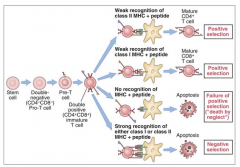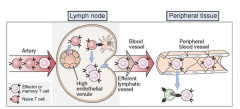![]()
![]()
![]()
Use LEFT and RIGHT arrow keys to navigate between flashcards;
Use UP and DOWN arrow keys to flip the card;
H to show hint;
A reads text to speech;
26 Cards in this Set
- Front
- Back
|
Lymphoid progenitor cells
|
Give rise to B cells, NK cells, and progenitor/precursor T cells
|
|
|
IL-7
|
Progenitor cells originating in the bone marrow differentiate to naïve mature T cells, under the influence of IL-7
|
|
|
TCR complex (Receptor)
|
- T-cell receptors (TCRs) are composed of two transmembrane polypeptide chains classified either as alpha/beta (α/β), or gamma/delta (γ/δ)
- α/β T cells = more than 90% - Each heterodimeric TCR is expressed on the cell surface with 5 invariant polypeptides = CD3 |
|
|
CD3
|
- Links the antigen binding receptor of the T cell with signaling pathways
|
|
|
Structure of T Cell Receptor
|
- A variable and a constant region
- TCRα variable regions are composed of a “V” and a ”J” segment (VJ) - TCRβ regions are composed of “V”, “D”, and “J” segments (VDJ) |
|
|
Diversity in T-Cells
|
1. Multiple copies of germline V, D, and J gene segments
2. Random selection and combination of V, (D) and J gene segments 3. Junctional diversity generated by the addition or deletion of bases 4. Random assortment of TCRα and TCRβ chains. |
|
|
T cell differentiation
|
- Thymic cortex
- CD2, pre-TCR-CD3 complex, CD4, CD8, TCR-CD3 complex, are expressed on the cell surface |
|
|
CD2
|
- 1st molecule to be expressed continues to be expressed throughout the life of the cell
- It is considered to be a “pan marker” |
|
|
CD3
|
- Continues to be expressed throughout the life of the cell
|
|
|
pre-TCR
|
- Only transiently expressed
- Critical in that the preTCR complex can only form on the developing thymocyte if the TCR beta chain variable |
|
|
CD4 and CD8
|
- Both CD4 and CD8 are expressed on the thymocyte (double positive T cell)
- Lineage selection occurs and the cells become either CD4+ or CD8+, not both (single positive) |
|
|
Somatic Recombination
|
- Initiated by recombinases, nucleoprotein products of the RAG-1 and RAG-2 genes (recombination-activating genes)
- During differentiation of the T cell the DNA in the locus is cut and recombined with the variable regions in the alpha chain and beta chain |
|
|
Allelic exclusion
|
- Somatic recombination is “inhibited”
- VJ or VDJ recombination is successful on one of the alleles (e.g, father‟s allele), then recombination will not occur on the other allele (mother‟s allele) - If the recombination is unsuccessful on both alleles, the cell dies |
|
|
Tolerance Induction
|
- T cells whose receptors are self-reactive = auto-immunity
- The random selection of V, D and J gene segments again leads to the generation of T cells expressing TCRs that may be autoreactive - These T cells must be deleted during the screening process in the thymus - this is done by selecting T cells to recognize self-MHC in the thymus |
|
|
Selection/Screening Processes in Thymic Cortex
|

- Double positive (CD4+, CD8+) thymocytes are selected to live or die depending on the interactive avidity of their TCR with self-antigen/MHC on thymic epithelial cells
- Interactive avidity dependent on: intrinsic affinity of the TCR for self antigen/MHC complex; density of TCRs;the density of self antigen/MHC complexes on the thymic epithelium; and density of antagonistic peptide complexes |
|
|
Negative Selection
|
- If recognition exceeds a pre-determined threshold, thymocytes are clonally eliminated or functionally inactivated by an active process termed negative selection
|
|
|
Lineage Selection
|
- Silencing of either the CD4 or the CD8 gene occurs in each individual T cell
- Lineages are classified by their expression of CD4 or CD8 (reflective of subsequent biological activity) |
|
|
Thymic Medulla
|
- Selection conditions in the medulla are different from those in the cortex
- More finely-tuned than in the cortex, with multiple high avidity interactions, including TCR, CD4 (CD8) and class II (class I) MHC all important |
|
|
AIRE Protein
|
- A transcription factor encoded by the autoimmune regulator (AIRE) gene, which promotes expression of peripheral tissue antigens in thymic epithelial cells and is essential for deletion (negative selection) of T cells specific for these antigens
- Mutations in AIRE lead to the autoimmune polyendocrine syndrome type 1 |
|
|
APECED syndrome
|
- Autoimmune polyglandular syndrome type 1 (APS1)
- Mutation in AIRE - >29 mutations have been identified - Manifests as chronic mucocutaneous candidiasis, hypoparathyroidism, autoimmune adrenal insufficiency |
|
|
CD4+ Thp and CD8+pCTL
|
- These two subsets of T cells are naïve T cells that will undergo antigen-induced differentiation in a secondary lymphoid organ following initial encounter with antigenic peptide-MHC
|
|
|
High endothelial venules (HEV)
|

- Migration of naive lymphocytes from the blood into lymph nodes occurs at specialized post capillary venules
- Glycocalyx on luminal surface that traps molecules |
|
|
Extravasation of naive lymphocytes into tissues at HEV requires
|
1. L-selectin on lymphocytes with its ligand on endothelial cells to induce lymphocyte rolling
2. Activation of integrins, (e.g.LFA-1) increasing their adhesiveness and allowing stable binding to HEV 3. Lymphocyte secretion of matrix metalloproteinases that proteolytically degrade collagen to generate 4. Transendothelial migration of lymphocytes into the tissue |
|
|
SUMMARY
|
1. Expression of CD2
2. Expression of PRE-TCR-CD3 complex ( Requires somatic recombination of beta chain ) 3. Expression of both CD4 and CD8 on the same cell 4. Somatic recombination of the alpha chain 5. Expression of TCR-CD3 complex 6. SELECTION -SCREENING (positive, negative, death by neglect) 7. Lineage Selection 8. Cross into medulla 9. Negative Selection 10. Exit to periphery 11. Effector cells that exit include CD4+Thp, CD8+pCTL |
|
|
Natural T Regulatory cells (nTregs)
|
- CD4+, CD25+, and FOXP3+ arise as a separate lineage in the thymus and exit to the periphery
- IMPORTANT in controlling self reactive T cells - Transcription factor FOXP3 (forkhead box p3) is necessary for development and function |
|
|
Mutations in FOXP3
|
- Mutations in FOXP3 develop a multi- organ autoimmune inflammatory disease “IPEX” (immune dysregulation, polyendocrinopathy, enteropathy, X-linked) syndrome
- Presents as watery diarrhea, eczema, and Type I diabetes (or other endocrine pathology) - Bone marrow transplantation or large doses of immunosuppression are required |

